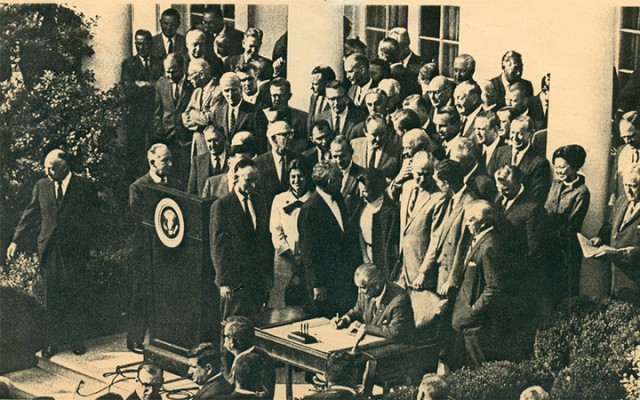The National Endowment for the Arts
04/26/2017 General

Briefly Legal is a monthly column in DOYLE Notebook. It is contributed by Lindsey Friedman, Esq. of Doyle’s Estate and Appraisal Services Department. Briefly Legal profiles current stories in the news and focuses on topics related to art law, estate planning and fiduciary practice.
The National Endowment for the Arts (NEA) was established by Congress as an independent federal agency that provides funding and support to artistic projects throughout America. It provides individuals with the opportunity to be involved with the arts and develop their creative endeavors. The NEA partners with state arts agencies, local leaders and other federal agencies and philanthropies to support and encourage arts education and to promote equal access to the arts in every community across the country.
The NEA originates from the National Foundation on the Arts and the Humanities Act, signed into law by President Lyndon B. Johnson on September 29, 1965. The act called for the creation of the NEA, as well as the National Endowment for the Humanities (NEH), as separate, independent agencies.
The groundwork for the NEA and NEH started in 1963 when several educational organizations joined together to establish the National Commission on Humanities, an organization intended to examine the state of the humanities in America. The Commission released a report in June 1964 suggesting that the emphasis on scientific education threatened the study of humanities throughout the education system. The Commission recommended the establishment of a National Humanities Foundation by the President, and in August 1964, Congressman William Moorhead of Pennsylvania proposed the new legislation. The White House proposed the establishment of the National Foundation of the Arts and Humanities, and Congress passed the bill in September 1965.
During his remarks at the signing of the bill, President Johnson stated, “In the long history of man, countless empires and nations have come and gone. Those which created no lasting works of art are reduced today to short footnotes in history’s catalog. Art is a nation’s most precious heritage. For it is in our works of art that we reveal to ourselves, and to others, the inner vision which guides us as a Nation.”
The NEA is advised by the National Council on the Arts in regards to agency policies and programs. The Council reviews and makes recommendations on applications for grants, funding guidelines and leadership initiatives. It was established in 1964 by the National Arts and Cultural Development Act, a year before the NEA was enacted by Congressional legislation.
When the National Foundation on the Arts and Humanities Act established the NEA in 1965, it allowed for 26 citizens to serve as advisors to the NEA as members of the National Council for the Arts. The Council’s first members, appointed by President Johnson, included artists such as Ralph Ellison, Paul Engle, Elizabeth Ashley, Gregory Peck, Oliver Smith, William Pereira, Minoru Yamasaki, George Stevens Sr., Leonard Bernstein, Agnes de Mille, David Smith and Isaac Stern. Members are appointed by the President based on their knowledge and expertise in the arts and are approved by the Senate for six-year alternating terms. Congress subsequently reduced the number of members on the Council, and there are currently 18 members as well as 6 members serving in a, non-voting role for two-year terms. Members are appointed to represent all geographical areas of the country equally.
According to the 2015 Annual Report, NEA’s 2015 fiscal year budget was $146,021,000 (0.004% of the overall federal budget), the same level as the previous fiscal year. The NEA awarded over 2,300 grants in each Congressional district in the country, with approximately half of the grants intended for underserved communities. The Annual Report states that by making direct grants, the NEA supports more than 30,000 concerts, readings and performances throughout America, more than 5,000 exhibitions of visual and media arts. These live performances achieve attendance of 33 million people, and broadcast performances on television, radio and cable have audiences of approximately 360 million viewers.
The NEA awards further generate more than $600 million annually in matching funds. The Annual Report states that, in annual grantmaking alone, the ratio of matches to federal funds will approach 10:1, well beyond the required non-federal match of at least one to one. 40% of the funds are awarded to partners such as the state arts agencies (SAAs) and regional arts organizations (RAOs). The SAAs and RAOs can fund arts education programs, regional touring projects and arts activities to underserved populations. These grants have reached more than 4,500 communities with grants made through these partnerships.
Regarding fiscal year 2018 budget, the NEA states on their website:
“The NEA remains open. The President’s FY (fiscal year) 2018 budget blueprint proposes the elimination of the National Endowment for the Arts. The President’s budget request is a first step in a very long budget process. The agency continues to operate as usual and will do so until a new budget is enacted by Congress. Our FY 2017 operations remain unchanged. We continue to make FY 2017 grant awards and will continue to honor all obligated grant funds made to date. Application recommendations scheduled for National Council on the Arts review on March 31, 2017 will proceed per the NEA’s normal grant process with an anticipated grant announcement later in the spring. In addition, we will continue to accept grant applications for FY 2018 at our usual deadlines.”
Sources:
https://www.arts.gov/
https://www.neh.gov/about/history
http://www.presidency.ucsb.edu/ws/?pid=27279